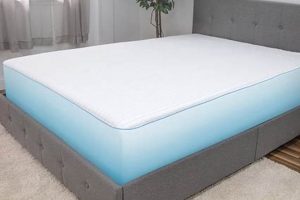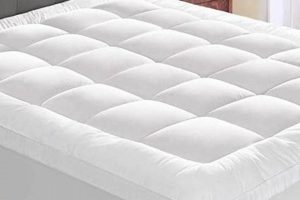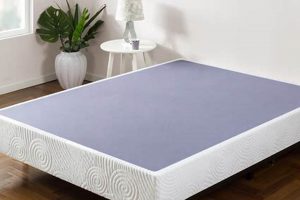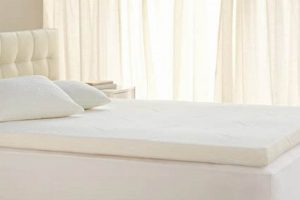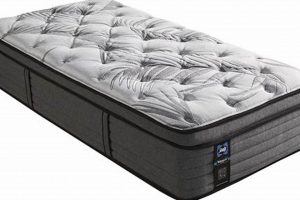A twin extra-long bed provides specific dimensions, generally measuring 38 inches in width and 80 inches in length. This elongated version of the standard twin bed offers additional legroom, making it a common choice for taller individuals or settings where space efficiency and individual sleeping arrangements are desired.
The extended length is particularly beneficial for adolescents and adults who require more space than a standard twin provides. This extra length contributes to improved sleep quality and comfort by preventing feet from hanging off the end. Historically, this dimension became prevalent in dormitories and other institutional settings needing accommodations for a diverse range of heights while maximizing room capacity.
Understanding these specific dimensions is critical when selecting appropriate bedding, including sheets, comforters, and mattress protectors. Furthermore, considering the overall room layout and available space is important to ensure the selected bedding configuration optimally fits within the intended environment.
Considerations for Twin XL Bedding
Selecting the proper bedding for a twin extra-long bed requires careful attention to detail. Deviations from specified measurements can impact comfort and overall functionality. The following guidelines provide crucial insights for optimal purchasing decisions.
Tip 1: Precise Measurement: Verify the actual dimensions of the bed frame before purchasing sheets or mattress protectors. Discrepancies, however slight, can lead to ill-fitting bedding, reducing comfort and increasing wear and tear.
Tip 2: Deep Pocket Sheets: When dealing with thicker mattresses or the addition of mattress toppers, opt for deep-pocket sheets. These accommodate extra depth, preventing the sheets from slipping off during use.
Tip 3: Durable Materials: Prioritize bedding constructed from durable and breathable materials such as cotton, linen, or microfiber. These materials offer longevity and enhance sleep quality through improved ventilation.
Tip 4: Mattress Protector Imperative: Investing in a waterproof mattress protector is crucial to safeguard against spills, stains, and allergens. This investment extends the lifespan of the mattress and maintains a hygienic sleeping environment.
Tip 5: Consider Comforter Dimensions: When choosing a comforter, ensure its dimensions adequately cover the mattress with sufficient overhang. This provides warmth and enhances the bed’s aesthetic appeal.
Tip 6: Regular Inspection: Routinely inspect bedding for signs of wear, such as thinning fabric or unraveling seams. Timely replacements prevent discomfort and maintain a clean sleeping space.
Tip 7: Wash According to Instructions: Adhere strictly to the manufacturer’s washing instructions to preserve the integrity of the bedding materials. Improper washing can cause shrinkage, fading, or damage to fibers.
Adhering to these guidelines ensures the long-term comfort, hygiene, and durability of bedding. Careful selection and maintenance not only enhance the sleep environment but also protect the financial investment in the mattress and related accessories.
By following this guide, it allows one to appreciate the comfort of using a twin XL setting.
1. Width Dimension
The width dimension of a twin extra-long mattress is a defining characteristic directly impacting its suitability for individual sleepers and spatial constraints. This measurement is a critical factor when considering comfort, functionality, and overall room design.
- Occupant Space and Comfort
The 38-inch width dictates the available lateral space for the occupant. This dimension influences freedom of movement during sleep and is particularly relevant for individuals who tend to shift positions frequently. Insufficient width can lead to restricted movement, potentially disrupting sleep quality. It affects single-sleeper comfort and isn’t intended for couples or co-sleeping arrangements.
- Room Layout Considerations
The defined width plays a pivotal role in determining optimal room layout, especially in compact spaces such as dormitories or smaller bedrooms. This fixed dimension allows for efficient arrangement of furniture and maximization of available floor area. Width influences the placement of other furniture items, ensuring ease of navigation and avoiding overcrowding.
- Sheet and Bedding Compatibility
Accurate width measurement is paramount for selecting appropriately sized sheets, blankets, and comforters. Standard twin sheets are designed for mattresses with a width around 38 inches. Deviations from this dimension can result in ill-fitting bedding, reducing comfort and compromising the aesthetic appeal of the bed. It will require specific dimensions to meet the requirements of the bedding.
- Single Occupancy Suitability
The width dimension signifies that this option is made for single person occupancy. A twin XL is made for individuals who want a comfortable space without the extra bed.
Ultimately, the width dimension of a twin extra-long bed defines its usability, influencing comfort, spatial efficiency, and compatibility with bedding accessories. Its fixed characteristic makes it suitable for environments where space is at a premium, and individual sleeping arrangements are required. Its importance should not be underestimated. This mattress provides a unique sleep configuration and offers an advantage to other mattress sizes.
2. Length Measurement
The length measurement is a critical attribute defining a twin extra-long mattress and fundamentally impacting its suitability for accommodating taller individuals. A precise understanding of this dimension is essential for optimizing sleep quality and ensuring physical comfort.
- Accommodation of Height
The 80-inch length primarily addresses the needs of taller sleepers, providing sufficient space to prevent discomfort from feet extending beyond the mattress edge. This feature contributes to uninterrupted sleep cycles, particularly beneficial for individuals exceeding the average height range. Without sufficient length, pressure points may develop, resulting in restless sleep.
- Dormitory and Institutional Relevance
In settings such as dormitories, residence halls, and other institutional environments, standardized lengths are crucial to accommodate a diverse range of occupant heights. The twin extra-long configuration offers a practical solution that minimizes the need for specialized or customized sleeping arrangements. This standardization simplifies logistics related to bedding and furniture procurement.
- Bedding and Accessory Considerations
The specific length dictates the dimensions of required bedding accessories, including sheets, mattress protectors, and comforters. Standard twin-sized bedding will not adequately fit a twin extra-long mattress, necessitating the purchase of specifically sized items. Purchasing the incorrect size of bed sheet can cause it to pop out.
- Overall Sleep Quality and Comfort
Adequate length directly contributes to improved sleep quality by allowing for unrestricted movement and preventing the feeling of being confined. This is particularly important for individuals who prefer to sleep on their backs or stomachs with extended legs. Restrictions in length can lead to muscle tension and compromised spinal alignment.
In summary, the length measurement of a twin extra-long mattress is a defining factor influencing comfort, practicality, and suitability for specific user demographics and institutional environments. Accurate measurement and consideration of length implications are vital for optimizing sleep quality and ensuring proper accommodation.
3. Surface Area
Surface area, in the context of a twin extra-long mattress, is the two-dimensional space available for a sleeper, directly derived from its length and width dimensions. Given the standard dimensions of 38 inches in width and 80 inches in length, the resulting surface area is 3,040 square inches, or approximately 21.1 square feet. This area dictates the degree of freedom a sleeper experiences and is a defining component of the mattress’s overall usability. A larger surface area generally equates to increased comfort and reduced restriction during sleep. In contrast, an insufficient surface area could lead to a cramped feeling and disrupted sleep patterns.
The implications of the specified surface area extend beyond mere comfort. For example, consider individuals with conditions requiring specific sleep positions or assistive devices. The provided surface area must accommodate these needs. In healthcare facilities, a proper surface area allows for ease of patient repositioning and reduces the risk of pressure sores. Furthermore, the surface area influences heat dissipation and ventilation, impacting thermal comfort. Bedding materials with enhanced breathability can further augment this aspect. Finally, consider the practicality in shared living spaces like dormitories where optimizing individual comfort within limited square footage is a primary concern; the mattress dimensions, and thus surface area, are carefully considered to balance space utilization and individual sleeper needs.
In conclusion, the surface area of a twin extra-long mattress, calculated from its standardized dimensions, is a critical factor influencing both physical comfort and practical application. Its adequate assessment ensures optimal accommodation of individual needs and contributes to overall sleep quality. Challenges in this domain typically involve balancing the desired surface area with spatial constraints, requiring careful consideration of room layout and intended usage. Understanding this relationship is crucial for institutions, retailers, and individual consumers aiming to provide or procure optimal sleeping arrangements.
4. Dorm Relevance
In the context of dormitory settings, the size characteristics of the twin extra-long mattress become particularly salient. The dimensions address specific constraints and needs inherent to shared living spaces, impacting student comfort and efficient space utilization.
- Space Optimization
Dormitories are often characterized by limited square footage, necessitating efficient use of available space. The twin extra-long mattress offers a narrow profile, allowing for optimal furniture arrangement and maximizing floor area. This configuration facilitates the accommodation of multiple students within a single room while preserving a degree of individual living space. For example, a standard dorm room might comfortably accommodate two twin extra-long beds, desks, and storage units, leaving adequate space for movement.
- Accommodating Diverse Heights
University and college populations exhibit a range of student heights, necessitating sleeping arrangements that cater to taller individuals. The extended length of the twin extra-long mattress addresses this requirement, preventing discomfort and promoting restful sleep for students exceeding the average height. This is a practical consideration for institutions aiming to provide comfortable and standardized accommodations.
- Standardized Bedding and Logistics
The widespread adoption of twin extra-long mattresses in dormitories simplifies logistical operations related to bedding procurement and inventory management. Institutions can purchase standardized sheets, comforters, and mattress protectors in bulk, ensuring consistency and reducing operational complexity. This standardization also benefits students, who can readily find appropriately sized bedding from various retailers.
- Cost-Effectiveness
From an institutional perspective, twin extra-long mattresses strike a balance between providing adequate comfort and maintaining cost-effectiveness. They offer a more affordable alternative to larger mattress sizes while still meeting the essential needs of most students. This cost-effectiveness is particularly important for institutions operating with limited budgets.
Ultimately, the “Dorm Relevance” of the twin extra-long mattress stems from its ability to optimize space, accommodate diverse student heights, simplify logistical operations, and offer a cost-effective sleeping solution. The dimensions are a deliberate response to the unique challenges and requirements of shared living environments, making it a prevalent choice in educational institutions worldwide.
5. Sheet Compatibility
Sheet compatibility is intrinsically linked to the dimensions of a twin extra-long mattress, with the stated measurements directly dictating appropriate bedding selection. Mismatched sheet sizes lead to functional and aesthetic compromises. Standard twin-sized sheets, designed for a 75-inch length, prove inadequate for the 80-inch length of a twin extra-long, resulting in improper fit and potential detachment during use. Conversely, queen or king-sized sheets are excessively large, creating bunching and discomfort. Therefore, specifically designated twin extra-long sheets are essential to ensure proper fit and optimal performance.
The availability and variety of bedding options directly correlate with demand. Retailers catering to college students or institutional clients typically maintain a larger selection of twin extra-long sheets compared to niche mattress sizes. This availability simplifies the purchasing process for consumers. Fabric type, thread count, and construction quality further influence comfort and longevity, factors consumers should consider when selecting appropriate bedding. Examples of acceptable materials include cotton, microfiber, and linen, each offering varying degrees of breathability and durability. A well-chosen sheet set not only enhances sleep quality but also prolongs the lifespan of the mattress.
In summary, sheet compatibility is a non-negotiable aspect of the twin extra-long mattress configuration. Selecting appropriately sized sheets ensures optimal comfort, longevity, and functionality. An understanding of the precise dimensions, readily available bedding options, and material characteristics allows informed purchasing decisions, benefiting consumers and institutions alike. The consequences of neglecting sheet compatibility extend beyond mere aesthetics, directly impacting the quality of sleep and the long-term viability of the mattress investment.
6. Frame Selection
The proper frame selection for a twin extra-long mattress is a critical determinant of support, stability, and longevity. The specific dimensions of this mattress size necessitate careful consideration to ensure the chosen frame adequately accommodates its physical attributes. Inadequate frame support can lead to premature mattress wear, compromised sleep quality, and potential structural instability.
- Dimensional Accuracy
Frame dimensions must precisely correspond to the standardized measurements of the twin extra-long mattress: 38 inches in width and 80 inches in length. A frame that is undersized will not properly support the mattress, leading to sagging and uneven weight distribution. Conversely, an oversized frame can allow the mattress to shift, creating instability and discomfort. Accuracy is paramount for optimal functionality.
- Support Structure and Load Capacity
The frame’s internal support structure must possess sufficient load capacity to withstand the weight of the mattress and its occupant. Slatted frames, for example, should have adequately spaced and reinforced slats to prevent sagging. Metal frames should be constructed from heavy-gauge steel to ensure structural integrity. Insufficient support can result in mattress deformation and decreased comfort over time.
- Material Compatibility
The material composition of the frame should be compatible with the mattress type to prevent damage or accelerated wear. For instance, certain metal frames may cause friction-related wear on mattresses with specific cover materials. Similarly, wooden frames should be properly sealed to prevent moisture absorption, which can lead to mold growth and mattress degradation. Compatibility mitigates potential adverse interactions.
- Bed Height and Accessibility
Frame selection directly influences bed height, which impacts accessibility and overall user comfort. A frame that is too low may make it difficult to get in and out of bed, particularly for individuals with mobility limitations. Conversely, an excessively high frame can pose safety concerns. The optimal bed height should facilitate ease of access while promoting proper spinal alignment during sleep.
In conclusion, frame selection is a fundamental consideration inextricably linked to the size of twin extra-long mattress. The dimensions of the frame influence the support, load capacity, material compatibility, and bed height characteristics of this mattress size, impacting overall quality and user experience. The factors highlighted above should be examined to maximize effectiveness.
Frequently Asked Questions
The following section addresses common inquiries regarding the dimensions and characteristics of a twin extra-long mattress, offering clarity on its suitability for various applications.
Question 1: What are the precise dimensions of a twin XL mattress?
The standardized dimensions are 38 inches in width and 80 inches in length. Deviations from these measurements are rare and should be verified prior to purchasing bedding or frames.
Question 2: Is a twin XL mattress the same size as a standard twin mattress?
No. While both share the same width (38 inches), the twin XL mattress is 5 inches longer than a standard twin (80 inches versus 75 inches). This additional length caters to taller individuals.
Question 3: What type of bedding is required for a twin XL mattress?
Standard twin-sized sheets will not adequately fit a twin XL mattress due to the difference in length. Specifically designated twin XL sheets are necessary for proper fit and functionality.
Question 4: Are twin XL mattresses suitable for adults?
Yes, particularly for single adults who require more legroom than a standard twin provides. The added length is beneficial for taller individuals who may otherwise experience discomfort.
Question 5: What is the primary application of twin XL mattresses?
These mattresses are frequently used in dormitories, college residence halls, and other institutional settings where space optimization and accommodation of diverse heights are paramount.
Question 6: Can two twin XL mattresses be combined to create a king-sized bed?
While two twin XL mattresses have a combined width equivalent to a king-sized bed (76 inches), there may be a noticeable gap or seam between the mattresses, potentially affecting comfort. Specialized connectors or mattress bridges can mitigate this issue.
This information should offer clarity regarding the dimensions and optimal use cases for this mattress configuration.
Consider consulting additional resources for information on related topics, such as mattress types and sleep hygiene practices.
Size of Twin XL Mattress
The preceding discussion elucidates the crucial attributes of the specific bed. Its dimensions, 38 inches in width and 80 inches in length, define its suitability for particular applications and user demographics. The extended length differentiates it from standard twin mattresses, catering specifically to taller individuals and institutional settings where space efficiency is paramount. Understanding these dimensions is fundamental for selecting appropriate bedding, optimizing room layouts, and ensuring adequate sleep comfort.
Continued awareness of standardized mattress sizes, including the characteristics of twin extra-long configurations, remains essential for informed consumer decisions and effective resource allocation within institutional environments. Ongoing research into sleep ergonomics and mattress technology will likely further refine the design and application of these products, contributing to enhanced sleep quality and overall well-being.


